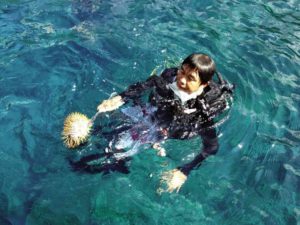
A diver shows, in this May 2013 photo, a crown of thorns (COT) starfish removed from the coral reef in Batangas City. On Oct. 20, 2018, in Malapascua Island in Cebu, a group of divers would remove COT in a 200 by 300 meter area in Malapascua Island where an outbreak in the population of these starfish had been discovered. INQUIRER FILE PHOTO
CROWN OF THORNS STARFISH OUTBREAK
Foreign and local diving enthusiasts and volunteers in Cebu will work together to control the outbreak of Crown of Thorns (COT)starfish on a portion of the coral reefs in Malapascua Island in Daanbantayan town in northern Cebu.
Kelsey Madison, site manager of the People and the Sea, said that an outbreak of COT, with a scientific name of Acanthaster planci, would pose a serious threat to the coral reefs health in the area.
So Madison and the People and the Sea, which is a non-government organization that focuses on marine conservation, organized a group of divers to remove COT on Oct. 20 in Malapascua Island.
“In small numbers they play an important ecological role by preventing the faster growing corals from outcompeting more slow growing species,” Madison said in a statement sent to Cebu Daily News.
“However, in large numbers they can decimate coral populations and therefore have a negative impact on other species that are dependent on the reef,” she added.
Ideal number
Lee Hankinson, lead science officer of the People and Sea, explained why this is so.
“So COTs naturally only occur in abundances of 1 to 5 per hectare. They mainly predate on the faster growing, branching corals, such as the Acropora species corals, Hankinson said.
“As these corals are the faster growing corals they use a lot of the natural substrate that hard corals use to grow on. So COTs feeding on these corals allow some of the slower growing coral species the opportunity to compete with them for substrate to settle and grow on. Hence, COTs can increase habitat complexity and diversity when at natural numbers,” he said.
The starfish has long spines, and they are purple or reddish-gray or green in color and have been known to prey on coral polyps.
Madison said that a large COT could consume around 400 centimeters (CM) of coral per day.
She said that the outbreak of COT had been due to the lack of natural predators that could control its numbers and the warmer seas that had
enhanced their larval development.
According to a 2013 Inquirer report, an official of the Protected Areas and Wildlife Bureau-Coastal and Marine Management Office (PAWB-CMMO), described a COT outbreak as a situation where hundreds of starfish species would be in one coral reef and that they would be too big to be eaten by their predators that would be mostly fish.
Outbreak area
Hankinson said on Monday that an estimate of the reef area where they found the outbreak was in a 300 by 200 meter reef area in Malapascua.
“There is a lot of reef habitat that have already been turned to rubble and also a lot of coral still remaining that they (COT) preferred to feed on,” Hankinson said.
He also said that there would be at least 20 divers who would help remove the COT from this area and they would be diving in a few different spots within the same reef area.
2,500 COT removed
Since January this year, volunteers from the People and the Sea on the island have removed around 2,500 COT in the seas off the eastern shore of Malapascua island.
The group had also collaborated with Sawum Freedivers group in Cebu, Malapascua Tour Guide’s Association and the Bantay Dagat of Malapascua and other local divers to help them safeguard their local reefs.
Madison said that the divers would undergo a briefing on the best methods to collect the COT.
“Any effort to mitigate outbreaks is appreciated, but without a basic understanding of ecological good practice this can cause more harm than good,” she said.
Madison said the divers would be implementing a “low cost and easy to repeat method” which would be the best way to remove COT.
Buckets would be floated on the surface and swimmers would dive down and would use tongs to collect the COT and then would be immediately brought to the surface and placed on the buckets, Madison said.
She said that they would also provide basic information such as the importance of removing COT.
“By coming together, we can make a much bigger impact and create a positive future for the island of Malapascua and the people who reside on it,” Madison added.
Disclaimer: The comments uploaded on this site do not necessarily represent or reflect the views of management and owner of Cebudailynews. We reserve the right to exclude comments that we deem to be inconsistent with our editorial standards.
